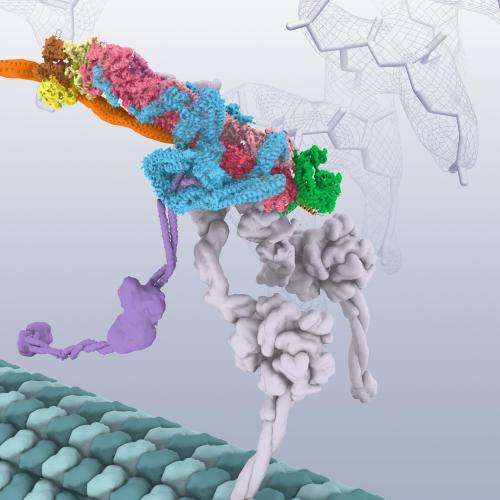Scientists uncover key cellular mechanism involved in neurodegeneration and herpes

A team of scientists have used Diamond to uncover vital new information about the transport mechanism that works within cells, distributing elements to different areas and thus supporting a range of different cellular processes.
The team from the MRC Laboratory of Molecular Biology in Cambridge was headed by Dr Andrew Carter. He explains the significance of cellular transport: "A cell is like a country. Different elements are produced in different areas, and it needs a transport network to distribute these elements effectively. We have uncovered new insights into how this process actually works, and how it can potentially go wrong, leading to diseases like neurodegeneration and herpes."
One of the key parts of the cellular transport network is dynein, a protein complex that functions like a tiny motor, travelling long distances to transport different cargos around the cell. Dynein carries things like mitochondria, which provide energy to the cell, and mRNAs, which contain the information to make new proteins. Dynein is essential to the proper functioning of the cell; however things can sometimes go wrong.
Part of dynein's role is to transport toxic elements called aggregated proteins away to be disposed of. Aggregated proteins are known to cause the death of nerve cells; which in turn leads to neurodegenerative conditions such as dementia and Parkinson's. We already know that when dynein goes wrong it can lead to neurodegeneration. Dynein is also at risk of being hijacked by certain viruses. Viruses in the herpes family, for example, attach themselves to dynein so that they can be transported to the nerve cell's nucleus where they lie dormant ready to be reactivated and cause outbreaks.
For the first time, scientists have now observed exactly how dynein transports cargo around the cell. This research could prove instrumental to the prevention of scenarios leading to nerve cell death and infection. The group discovered that dynein works because another protein, known as a 'cargo adaptor', attaches to it, causing it to bind with yet another protein: dynactin. This creates an intricate protein complex and sets off a reaction that causes dynein to move around the cell, transporting its cargo.
This research opens up exciting possibilities for further study. The team suspects that the cargo adapter that binds to dynein varies depending on the cargo that is being carried – so there will be a different adaptor for mitochondria, for mRNA, and so on. The next step is for researchers to investigate other cargo adapters, to expand our understanding of the transport network.
This is highly significant research; understanding exactly how the cellular transport network functions could allow us to intervene and prevent things from going wrong. This work could have future implications for the design of medical therapies for both neurological conditions and herpes.
Dr Andrew Carter comments: "dynein and dynactin are really challenging to work with, but my team did an amazing job. We found it fascinating to discover how it works and look forward to future developments in understanding how it contributes to human diseases".
The research was supported by the I03 beamline at Diamond, where the team determined the crystal structure of part of the protein complex at the heart of the transport mechanism. The team also used cryo-electron microscopy at the MRC Laboratory of Molecular Biology in Cambridge. Cryo-EM is an advanced technique that allows scientists to study biological process in intricate detail, and Diamond is currently building its own cryo-EM facility, which will be opening in late 2015. Diamond's Life Sciences Director, Dave Stuart comments: "Diamond is delighted to be home to this new facility and it is hoped that through this major advances in visualising sub cellular mechanisms will be made."
The findings of the MRC team opens up many new possibilities for research into cellular transport networks and their role in disease. This work could be an early stage in discovering new ways of preventing things going wrong within the networks, thus leading to new therapies for some of nature's most hard to treat diseases.
Provided by Diamond Light Source

















